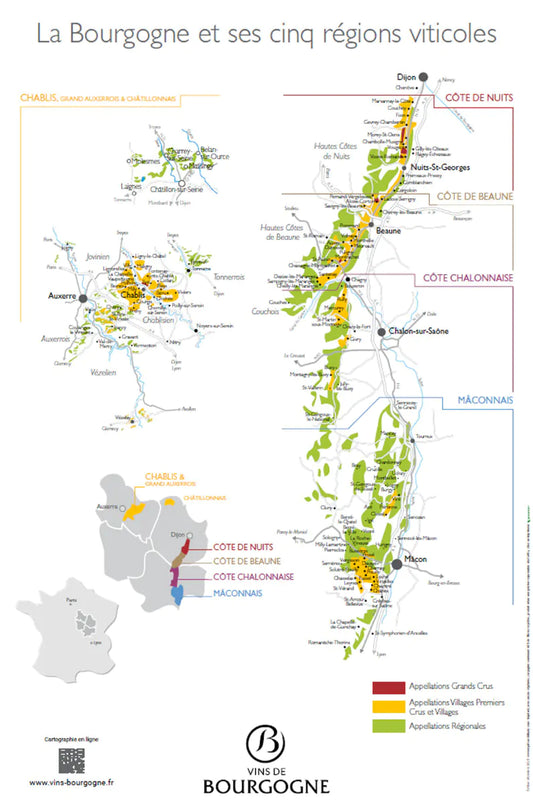Burgundy: World-class diversity


Two grape varieties dominate: Chardonnay , around the small town of Chablis where it produces fresh and taut wines; on the Côte d'Or, Pinot Noir reigns as undisputed master, and produces among the most expensive wines in the world.
In the Chablis region located in the north of Burgundy, Chardonnay is grown exclusively, on hillsides rich in limestone. Of the 6,834 authorized hectares, 4,500 are currently planted. There are four levels of quality: The AOC Petit Chablis produces entry-level wines. Then come the AOC Chablis, then the Premiers Crus and at the top of the pyramid the Grands Crus. Most winegrowers vinify their wines in stainless steel vats, but some mature their wines in new or used barrels.
Two monastic orders, the Cistercians of the Abbey of Notre-Dame de Cîteaux to the west of Nuits-Saint-Georges and the Benedictines of the Abbey of Cluny to the northwest of Mâcon have greatly contributed to the development of the quality of Burgundy wines and the establishment of Pinot Noir throughout Europe.
The Côte d'Or stretches over a narrow strip from Marsannay, near Dijon, to Cheilly on the south-east facing hillsides of the Morvan massif. In the vineyard, practically all the lines are oriented from northwest to southeast. Thus, the cold can flow towards the plain and the vines are warmed in the early morning by the first rays of sun. Spring frost is not as feared as hail. The continental climate and limestone soils are particularly suitable for the production of Pinot Noir, Chardonnay and Aligoté.
On the fertile plain, east of the D974 road, fleshy Pinot Noir and Chardonnay are produced, marketed under the appellation Bourgogne Grand Ordinaire or Bourgogne Passetoutgrain. On the top of the hills, the climate is cooler; Hautes Côtes, fresh and fruity wines, are produced there.
The band of Côte d'Or vintages is shared between Côte de Nuits, from Dijon to Beaune and Côte de Beaune, from Beaune to Cheilly. From a taste point of view, it is recommended to discover Burgundy from the south. The Pinot de Cheilly and Santenay are fresh and fruity. Chassagne- and Puligny-Montrachet offer privileged terroirs for Chardonnay as well as in Meursault. Monthélie, Volnay and Pommard produce silky Pinot Noir. Beaune as well as Aloxe-Corton and Nuits-St-Georges which is already in Côte de Nuits are recognized for their power. Vosne-Romanée, Vougeot and Chambolle-Musigny produce wines of great finesse. Morey-St-Denis and Gevrey-Chambertin are also prone to producing powerful wines.
It is necessary to devote particular attention to the municipalities of Vosne-Romanée, Vougeot and Chambolle-Musigny. Grands Crus such as La Romanée (0.83 ha) Romanée-Conti (1.8 ha) Musigny (10.85 ha) or Les Echezeaux (30 ha) can reach prices of several thousand francs per bottle.
Worthy wines for less money can be found in appellations such as Rully, Mercurey, Givry or Montagny. The Mâconnais is renowned for its Pouilly-Fuissé Chardonnay. Near there is the small town of Chasselas .
